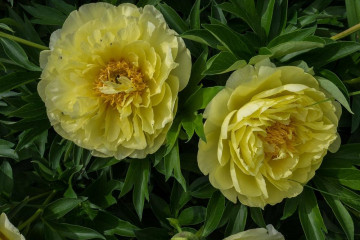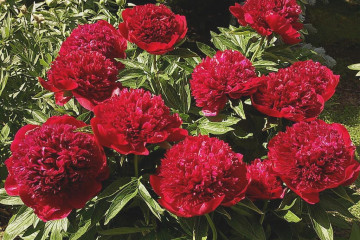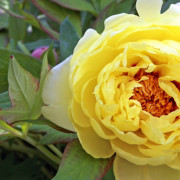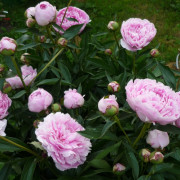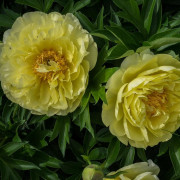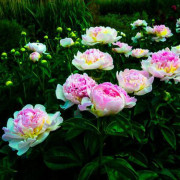Tree peony - description of the species, the best varieties for the garden
Content:
The most beautiful garden plants include the tree-like peony, which is often used to decorate a home garden plot. The plant is used in landscape design.
Tree peony - what is this species, history of creation
Representatives of the species are common in China, where it has been cultivated for almost 2 thousand years. There are varieties of Japanese, American and European origin.
Brief description, characteristic
The culture is represented by shrubs of a deciduous type, growing up to 2 m. They have erect stems that increase in volume over the years. The plant has openwork foliage and buds of various colors, from snow-white to greenish.
Advantages and disadvantages of the view
The advantages of growing include:
- annual long and abundant flowering;
- shrub life span;
- no need to prune old buds to stimulate the development of new ones.
What is the difference between a tree peony and a herbaceous
| Specifications | Tree-like | Grassy |
| Appearance | shrub with developed roots | ordinary flower |
| Cold snap behavior | sheds leaves | stems and shoots die off |
| Time of the appearance of flowers | May June | mid June |
| Life span | over 50 years | 10-20 years |
| Height | up to 2 m | up to 1 m |
| First buds | in 4-5 years | for the next season |
Tree peonies survive the winter well in the middle lane and do not require additional shelter.
Use in landscape design
The crop is often planted singly in the middle of a regular lawn; in group planting, it is alternated with plants of similar size. When decorating a garden, it is necessary to take into account the long lifespan of a peony - the constant removal of a number of planted subspecies can affect its condition.
Classification of tree peonies
There are three main subspecies of culture: Sino-European, Japanese and hybrid.
Sino-European
Known for their double-flowered buds with tight-fitting large petals. Heavy flowers spoil the decorative effect - under their weight, the peduncle bends.
Japanese
They have semi-double and non-double inflorescences, plant buds are large, but light. A feature of the subspecies is good frost resistance.
Hybrid
The result of mixing the two subspecies outwardly resembles peony trees.Appeared as a result of the work of the Japanese breeder Toichi Ito.
The varieties most in demand among gardeners
Florists give preference to certain varieties of culture.
The Qiao sisters
The shrub is known for its two-colored petals:
- on the one hand - pale pink and milky white;
- with the second - crimson and red.
The middle of the buds is golden yellowish. The Kiao Sisters have medium-sized flowers that densely dot the bush.
Kinko
Crown-type flowers with a golden hue and bright red edging, with a diameter of up to 17 cm. The plant grows up to 1.5 m, prefers alkaline fertile soils.
Blue Sapphire
It has bluish-pinkish petals with dark purple blotches. It is characterized by rapid growth and development.
Red Giant
Known for short stems and erect red buds. It grows quickly and has many flowers.
Green Beans
It is determined by the corrugated terry buds of a pale green color. Refers to late-flowering subspecies with a pleasant aroma.
Coral Altar
The bicolor buds are white and salmon colored. The diameter does not exceed 20 cm.
Secret Passion
The medium-sized shrub is covered with red-purple flowers, covered with bright greenery. It is resistant to disease, characterized by early and massive bud opening.
Lily scent
It is famous for its snow-white petals and high growth. The plant is planted in compositions with coniferous and deciduous species.
Hemoza Giant
A tall culture is decorated with light red crown-type buds with a diameter of 16 cm.The bushes have large foliage, they are well adapted to diseases and pest attacks.
Scarlet Sails
Decorated with crown red-purple flowers with a diameter of up to 16 cm. It grows up to 2 m, it can simultaneously eject up to 70 buds.
Red Wiz Pink
It grows up to 1.2 m, flowers are wavy, double. Cherry red petals with pale pink strokes, each flower is different in color.
Coral island
Reaches 1.5 m, has light red buds with a diameter of 15 cm. Blossoms in mid-July.
Yaos Yellow
It is characterized by a light yellow shade of flowers, it develops quickly. Requires winter shelter due to poor frost tolerance.
Pink River
The buds resemble lotus flowers with pale pink tones. The plant is known for its unpretentiousness and resistance to diseases and pests.
Pink lotus
The culture has lacy petals with a pale pink tint, stamens of golden and black color. The buds resemble a lotus.
Peach under the snow
It grows up to 1.2 m, blooms in the middle of the season. The buds last for 2 weeks.
Others
Attention is drawn to the Green ball with spherical flowers of a pale greenish color. After blooming, they turn pink. The plant is tall, the diameter of the buds is up to 18 cm.
Growing a flower, how to plant it in open ground
A tree peony is bred in several ways. Reproduction is considered to be the simplest by dividing an adult flower. Breeding can be carried out by seeds, cuttings and shoots.
Planting by root cuttings
It is convenient to divide peonies at the rhizome level. This approach allows you to get several independent shrubs, renew an old plant.
What time is the boarding
Florists recommend planting a peony in open ground in August-September, depending on the region of growth.
Location selection
It is better to grow a peony in partial shade. The place must be protected from winds, the distance between plants is at least 1.5 m.
How to prepare the soil and flower for planting
Before planting, the roots of the culture are soaked for half an hour in Kornevin or Heteroauxin.The landing site is prepared in advance: the depth is up to 70 cm, the width is according to the volume of the root system. Up to 30 cm of the hole is allocated for drainage, which is filled with expanded clay or gravel.
Sand and organic fertilizers are added to clay rock, lime (up to 300 g) is added to sour rock. Sandy lands are enriched with humus, peat and sod land.
Planting procedure step by step
The peony reproduces according to the scheme:
- The plant is dug in and carefully pulled out.
- Shake off the soil from the roots.
- The roots are cut to 15 cm, washed in warm water, left to dry for 2-3 hours.
- The shrub is divided into parts, each must have 2 buds and a root of 10 cm.
- After division, damaged and rotten roots are excised
- The plant is disinfected with potassium permanganate and planted in prepared pits.
- The voids are filled with earth.
Planting with seeds (for breeding)
The difficulty of growing a peony from seeds is that the seed needs to be stratified in 2 stages:
- Warm - the seeds are kept in wet sand at a temperature of 20-30 degrees, up to the first roots.
- Cold - they are moved to the substrate (10-15 degrees) and the first leaves are waiting.
During transplantation, the leaves are pinched. From the spring months, seedlings are hardened and planted in a greenhouse.
Tree peony - care and cultivation
Keeping an eye on a culture is easy, the main thing is to follow the recommendations given in its description.
Watering and feeding
In summer, the soil is moistened once every 2 weeks, 7 liters of water are consumed for each shrub. If the weather is hot and dry, then the amount of watering is increased, focusing on the condition of the soil and plants. Starting in August, the frequency of procedures is gradually reduced, and in September, they are completely excluded.
Plants require fertilization:
- in the first weeks of the growing season - solutions with nitrogen;
- during the formation of buds and before the end of the growing season - feeding with potassium and phosphorus.
Mulching and loosening
They loosen the soil after each watering, capturing a radius of up to 0.5 m around the flower. At the same time, they get rid of weeds. Loosening is carried out to a depth of 5 cm, after the end of the procedure, the periosteal circle is mulched with peat or humus.
Preventive treatment
To prevent damage to culture, prophylaxis is carried out:
- Before planting, the wells are watered with a solution of potassium permanganate - up to 3 g per 10 liters of liquid.
- In spring, sprinkling with 0.5% copper sulfate is sometimes carried out - until the buds open.
Blooming tree peonies
Shrub buds grow up to 20 cm in diameter, they are semi-double, simple or double type. The flowers are famous for the variety of colors: white, purple, crimson, yellowish, pink and two-tone tones.
A period of activity and rest
Shrubs budding is observed from June to September and depends on their variety. The average duration is 14 to 21 days.
Care during and after flowering
When forming buds, the plant is fed with a solution of Nitrofoski (25 g per bucket of water) - up to 7 liters for each bush. After blooming, up to 2 glasses of wood ash are poured under each shrub.
What to do if it does not bloom, possible reasons
The reasons for the lack of bud formation or their active dropping:
- lack or excess of fertilizers;
- waterlogging or underfilling of water;
- insect attacks and disease.
Peonies after flowering
After the buds have faded, the plant needs help.
Transfer
You can propagate and carry out transplant work in the fall.The best option is to divide adult plants over 4-5 years old.
Pruning
After the flowers have dried, the shoots are cut to the upper bud, the dry buds are removed.
Preparing for winter
All shrubs must be covered for the winter, especially in Siberia. This approach helps to avoid freezing of the buds in the spring with recurrent frosts. Spruce branches, dry foliage and covering material are used as shelter.
Diseases, pests and ways to control them
The main parasite of peonies is fungi that grow near the roots on the trunks. They must be removed, otherwise the parasites will cause the death of the culture.
Common shrub diseases:
- fungal infections;
- gray rot;
- viral diseases.
When signs of disease appear, peonies are treated with a weak solution of potassium permanganate or fungicides. Plants that are improperly looked after are more often affected. Compliance with the rules will help prevent the occurrence of pathologies.
The enemies of the shrub include vole mice gnawing at its roots. To prevent their attacks, the plants are planted in a special net.
A tree peony can be a decoration for any garden plot. At the same time, the plant does not require special growing conditions and has a simple care scheme. For timely and lush flowering, it is necessary to water the flower in a timely manner, feed it with nutritious mixtures and carry out prophylaxis against pests and diseases.








